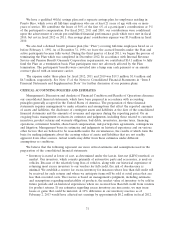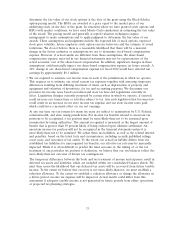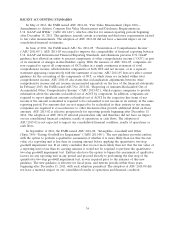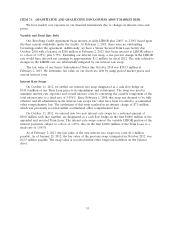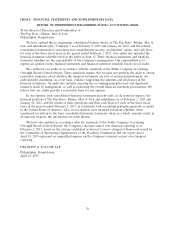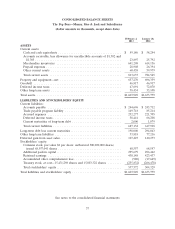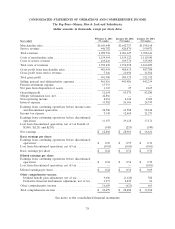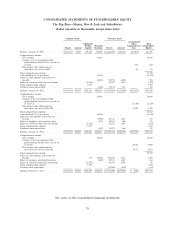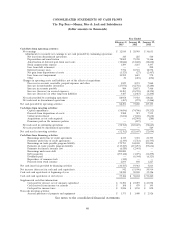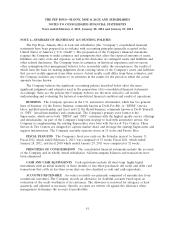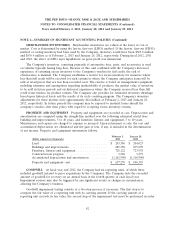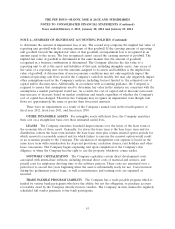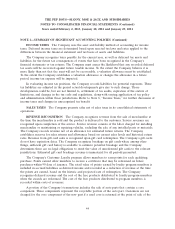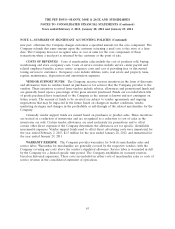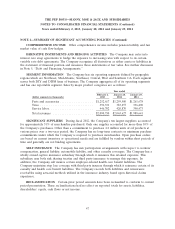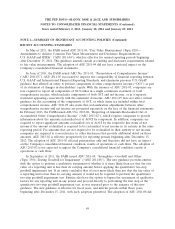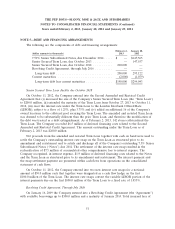Pep Boys 2012 Annual Report Download - page 80
Download and view the complete annual report
Please find page 80 of the 2012 Pep Boys annual report below. You can navigate through the pages in the report by either clicking on the pages listed below, or by using the keyword search tool below to find specific information within the annual report.THE PEP BOYS—MANNY, MOE & JACK AND SUBSIDIARIES
NOTES TO CONSOLIDATED FINANCIAL STATEMENTS
Years ended February 2, 2013, January 28, 2012 and January 29, 2011
NOTE 1—SUMMARY OF SIGNIFICANT ACCOUNTING POLICIES
The Pep Boys—Manny, Moe & Jack and subsidiaries (the ‘‘Company’’) consolidated financial
statements have been prepared in accordance with accounting principles generally accepted in the
United States of America (‘‘U.S. GAAP’’). The preparation of the Company’s financial statements
requires the Company to make estimates and assumptions that affect the reported amounts of assets,
liabilities, net sales, costs and expenses, as well as the disclosure of contingent assets and liabilities and
other related disclosures. The Company bases its estimates on historical experience and on various
other assumptions that management believes to be reasonable under the circumstances, the results of
which form the basis for making judgments about carrying values of the Company’s assets and liabilities
that are not readily apparent from other sources. Actual results could differ from those estimates, and
the Company includes any revisions to its estimates in the results for the period in which the actual
amounts become known.
The Company believes the significant accounting policies described below affect the more
significant judgments and estimates used in the preparation of its consolidated financial statements.
Accordingly, these are the policies the Company believes are the most critical to aid in fully
understanding and evaluating the historical consolidated financial condition and results of operations.
BUSINESS The Company operates in the U.S. automotive aftermarket, which has two general
lines of business: (1) the Service business, commonly known as Do-It-For-Me, or ‘‘DIFM’’ (service
labor, installed merchandise and tires) and (2) the Retail business, commonly known as Do-It-Yourself,
or ‘‘DIY’’ (retail merchandise) and commercial. The Company’s primary store format is the
Supercenter, which serves both ‘‘DIFM’’ and ‘‘DIY’’ customers with the highest quality service offerings
and merchandise. As part of the Company’s long-term strategy to lead with automotive service, the
Company is complementing the existing Supercenter store base with Service & Tire Centers. These
Service & Tire Centers are designed to capture market share and leverage the existing Supercenter and
support infrastructure. The Company currently operates stores in 35 states and Puerto Rico.
FISCAL YEAR END The Company’s fiscal year ends on the Saturday nearest to January 31.
Fiscal 2012, which ended February 2, 2013, was comprised of 53 weeks. Fiscal 2011, which ended
January 28, 2012, and fiscal 2010 which ended January 29, 2011 were comprised of 52 weeks.
PRINCIPLES OF CONSOLIDATION The consolidated financial statements include the accounts
of the Company and its wholly owned subsidiaries. All intercompany balances and transactions have
been eliminated.
CASH AND CASH EQUIVALENTS Cash equivalents include all short-term, highly liquid
investments with an initial maturity of three months or less when purchased. All credit and debit card
transactions that settle in less than seven days are also classified as cash and cash equivalents.
ACCOUNTS RECEIVABLE Accounts receivable are primarily comprised of amounts due from
commercial customers. The Company records an allowance for doubtful accounts based upon an
evaluation of the credit worthiness of its customers. The allowance is reviewed for adequacy at least
quarterly, and adjusted as necessary. Specific accounts are written off against the allowance when
management determines the account is uncollectible.
41


